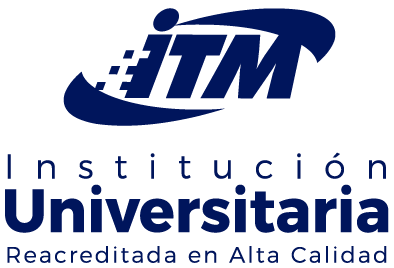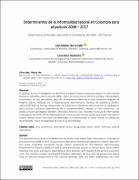| dc.contributor.author | Berrio-Calle, Juan Esteban | |
| dc.contributor.author | Bran-Piedrahita, Lemy | |
| dc.date.accessioned | 2019-07-18T14:45:20Z | |
| dc.date.accessioned | 2019-08-01T22:55:19Z | |
| dc.date.available | 2019-07-18T14:45:20Z | |
| dc.date.available | 2019-08-01T22:55:19Z | |
| dc.date.issued | 2019-01-30 | |
| dc.identifier | https://revistas.itm.edu.co/index.php/revista-cea/article/view/1255 | |
| dc.identifier | 10.22430/24223182.1255 | |
| dc.identifier.uri | http://hdl.handle.net/20.500.12622/606 | |
| dc.description.abstract | El objetivo de esta investigación es identificar los determinantes clave que explican la informalidad laboral en Colombia, para el período 2008 – 2017. En el proceso se utilizó un enfoque metodológico cuantitativo, de tipo descriptivo, para ello se emplearon datos de la Gran Encuesta Integrada de Hogares (GEIH), realizada por el Departamento Administrativo Nacional de Estadística (DANE), además de diversas fuentes referenciales de la literatura, donde los determinantes se catalogaron como cíclicos y acíclicos, dependiendo de su comportamiento, respecto al ciclo económico. Los análisis arrojan que Bogotá, Medellín, Manizales, Pereira y Cali, presentan las tasas de informalidad más bajas (entre 40 % y 50 %). Adicionalmente, entre las conclusiones resalta que existe una relación lineal o directa entre la duración del desempleo y la informalidad; a mayor tiempo en calidad de desempleado, mayor probabilidad de caer en la informalidad. | spa |
| dc.format.mimetype | application/pdf | |
| dc.language.iso | spa | |
| dc.publisher | Instituto Tecnológico Metropolitano - ITM | spa |
| dc.relation | https://revistas.itm.edu.co/index.php/revista-cea/article/view/1255/1163 | |
| dc.rights | Derechos de autor 2019 Instituto Tecnológico Metropolitano | spa |
| dc.rights | https://creativecommons.org/licenses/by-nc-sa/4.0/ | spa |
| dc.source | 2422-3182 | |
| dc.source | 2390-0725 | |
| dc.source | Revista CEA; Vol 5 No 9 (2019); 33-51 | eng |
| dc.source | Revista CEA; Vol. 5 Núm. 9 (2019); 33-51 | spa |
| dc.subject | ciclo económico | spa |
| dc.subject | desempleo cíclico | spa |
| dc.subject | desigualdad social | spa |
| dc.subject | sector informal | spa |
| dc.subject | sistema económico | spa |
| dc.title | Determinantes de la informalidad laboral en Colombia para el período 2008 – 2017 | spa |
| dc.title.alternative | Determinants of the labor informality in Colombia for the 2008 - 2017 period | eng |
| dc.type.spa | Artículos | spa |
| dc.subject.keywords | economic cycle | eng |
| dc.subject.keywords | cyclical unemployment | eng |
| dc.subject.keywords | social inequality | eng |
| dc.subject.keywords | informal sector | eng |
| dc.subject.keywords | economic system | eng |
| dc.type | info:eu-repo/semantics/article | |
| dc.type | info:eu-repo/semantics/publishedVersion | |
| dc.type | Articles | eng |
| dc.relation.ispartofjournal | Revista CEA | |
| dc.description.abstractenglish | The objective of this study is to identify the key drivers that explain labor informality in Colombia in the period from 2008 to 2017. A quantitative descriptive method was adopted to analyze data from the Great Integrated Household Survey (GEIH) conducted by the National Administrative Department of Statistics (DANE) as well as several important sources in the literature. Drivers were classified into cyclic and acyclic, depending on their behavior with respect to the general economic cycle. The analysis revealed that Bogotá, Medellín, Manizales, Pereira, and Cali present the lowest rates of informal employment in the country (between 40% and 50%). Additionally, the most outstanding conclusion is that there is a linear or direct relationship between the length of unemployment and informality: the longer individuals are unemployed, the more likely they are to join the informal sector. | eng |
| dc.rights.accessrights | info:eu-repo/semantics/openAccess | |
| dc.type.coar | http://purl.org/coar/resource_type/c_6501 | |


